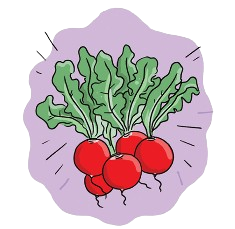Learn to grow microgreens at home, join Grow It Local +
How to grow
Join Our Community
Learn to grow and cook healthy, delicious, organic food at home by joining our seasonal grow-alongs.
Join Our Community
Learn to grow and cook healthy, delicious, organic food at home by joining our seasonal grow-alongs.
Growing Tips and Tricks
Location:
Radishes prefer cool weather and can be grown in both full sun and partial shade. In warmer regions, it’s best to plant radishes during the cooler months of the year. The soil should be well-draining, loose, and rich in organic matter.
Watering:
Radishes require consistent moisture for even growth. Keep the soil evenly moist but not waterlogged. In hot weather, you may need to water the plants more frequently, but in cooler weather, watering once or twice a week should be sufficient.
Problems:
Pests: Radishes are relatively resistant to pests, but keep an eye out for cabbage root maggots, flea beetles, and aphids. Keep plants well fed and healthy to minimise the risk of pest attack
Diseases: Radishes are generally disease-resistant, but overwatering can lead to fungal problems. Ensure the soil has good drainage to prevent disease issues.
Bolting: Radishes can bolt and become bitter in hot weather. To avoid this, plant radishes during the cooler seasons and choose quick-maturing varieties.
Cracking: Rapid fluctuations in moisture levels can cause radishes to crack. Maintain consistent soil moisture to prevent cracking.
Harvest:
Radishes are typically ready for harvest within 3-6 weeks after sowing, depending on the variety. Harvest radishes when they reach the desired size, usually around 2.5-5 cm in diameter for most varieties. Gently pull or dig them out of the soil, and trim the tops before storing.
Background
The exact origin of red ball radish is unclear, but it is believed to have originated in Southeast Asia, particularly in China and Japan, where wild varieties of radishes were present. The early domestication and cultivation of radishes likely began in ancient times.
As trade routes expanded, radishes spread to various parts of the world. The ancient Egyptians, Greeks, and Romans were known to grow and consume radishes, appreciating their crisp texture and peppery flavour.
As trade routes expanded, radishes found their way to other parts of the world. They were introduced to Europe by the 16th century, where different varieties were developed through selective breeding.
Radishes made their way to the Americas with European colonists in the 16th and 17th centuries. Native American tribes also adopted radishes into their agricultural practices.
Health Benefits
Homegrown organic radishes are good for you!
Radishes are an excellent source of vitamins (C and B6) and minerals (potassium and manganese).
Eating radishes can help support immune function and promote healthy skin due to their vitamin content.
They are rich in antioxidants, such as anthocyanins, which help protect against oxidative stress and inflammation.
Red radishes also contain fibre, which aids digestion and supports a healthy gut
Patch to plate
You can’t beat the crunchy texture of a freshly harvested radish, straight from the patch! The best way to eat them is straight out of the ground, but if a few did make their way into your kitchen, here’s some inspiration for your radically delicious radishes.
- Cut in half and used on a plate of raw vegetables, dips and cheeses
- Roasted and served with brown butter and herbs
- Thinly sliced and served with pickled red onion




